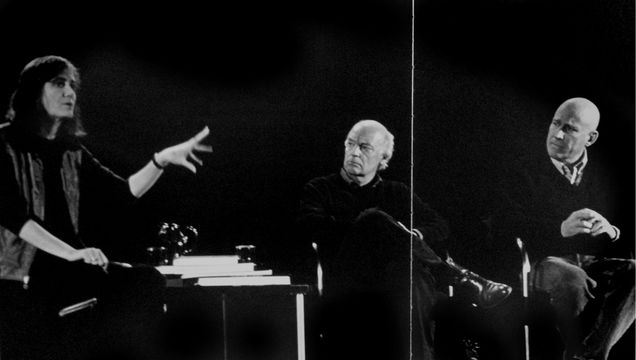
Guests
- Sebastião SalgadoBrazilian photojournalist. Among numerous international awards, he received the W. Eugene Smith Grant for Humanistic Photography and was named Photographer of the Year two times by the International Center for Photography.
- Eduardo GaleanoUruguayan writer and journalist. He is one of the most celebrated writers in Latin America. He is author of many books, including “Open Veins of Latin America” and the trilogy, “Memory of Fire.”
Today, an end-of-millennium conversation with two giants of literature and politics. Perhaps more than any other living photographer, Sabastião Salgado’s images of the world’s poor stand in tribute to the human condition. He defines his work as militant photography.
Trained as an economist, Salgado began working as a photojournalist in 1973. Among numerous international awards, he received the W. Eugene Smith Grant for Humanistic Photography and was named Photographer of the Year two times by the International Center for Photography.
Salgado left Brazil in 1969 to avoid imprisonment under the dictatorship, ultimately settling in France. For his 1993 book, “Workers: An Archeology of the Industrial Age,” Salgado traveled through Europe, India, Africa and South America. His new book, “Migrations,” is the product of a seven-year trek to more than 35 countries in which he documented the world-altering phenomenon of mass migration. From a lonely corpse left behind in the desert to the pallid face of a refugee child, his images capture the beauty and brutality of life for those forced to leave their homes and traditions.
Uruguayan writer Eduardo Galeano is a writer, journalist and historian. His work, from the trilogy “Memory of Fire” to the classic “Open Veins of Latin America,” ranges across the post-conquest Americas to uncover a heritage of oppression and resistance beneath the facade of official stories.
Born in 1940 in Montevideo, Galeano began writing newspaper articles as a teenager. By the age of 20, he became editor-in-chief of La Marcha, and a few years later he took the top post at Montevideo’s daily newspaper “Epocha.” At 31, he wrote his most famous book, “Open Veins of Latin America: Five Centuries of the Pillage of a Continent.” He was imprisoned in Uruguay and lived in exile in Argentina and Spain before returning home. His newest book, “Upside Down: A Primer for the Looking-Glass World,” exposes the absurdity of the modern world that teaches us “to suffer reality, not change it,” a world where poverty kills, people are hungry, machines are more precious than humans, and children work from dark to dark. Galeano is the recipient of the first Lannan Prize for Cultural Freedom.
They spoke at the College of Santa Fe, New Mexico, in an event sponsored by the Lannan Foundation.
Transcript
AMY GOODMAN: Well, today, an end-of-the-millennium conversation with two giants of the arts, two militant artists. More than any other living photographer, Sebastião Salgado’s images of the world’s poor stand in tribute to the human condition. He defines his work as militant photography. Trained as an economist, the Brazilian photographer Salgado began working as a photojournalist in 1973. Among numerous international awards, he received the W. Eugene Smith Grant in Humanistic Photography and was named Photographer of the Year two times by the International Center for Photography. His new book, Migrations, is the product of a many-year trek to more than 35 countries in which he documents the world-altering phenomenon of mass migration. In his 1993 book, Workers: An Archaeology of the Industrial Age, Salgado traveled through Europe, India, South America to document the lives of all of us who work for a living — farmers, computer programmers, gold miners. Despite the grim poverty and pain he often captures, Salgado’s ultimate message is one of endurance and hope.
And then there’s Eduardo Galeano, one of Latin America’s most distinguished writers, journalists and historians, author of Memory of Fire, Open Veins of Latin America and Soccer in Sun and Shadow. He was born in Montevideo, Uruguay. He lived in exile in Argentina and Spain for many years, after being imprisoned in Uruguay, and has received last year the first Lannan Prize for Cultural Freedom.
Recently, I had the opportunity to go to Santa Fe, where I conducted a public interview with Salgado and Galeano at the College of Santa Fe. The event was sponsored by the Lannan Foundation. And this hour, we will spend with Eduardo Galeano and Sebastião Salgado.
AMY GOODMAN: Well, thank you very much for coming out today, though I don’t think it took too much to entice you to get a chance to hear these two giants of literature and photography, Eduardo Galeano and Sebastião Salgado. It is a tremendous privilege for me to be able to engage in a discussion with you.
Mainly, I just want to spend a little time encouraging you to speak. The motto of the program we do is really both speaking for yourselves and the exception to the rulers, which I think you both very much are. I’ve spent the fall immersed in both of your works, and, at the same time, the backdrop has been the presidential elections here in the United States. And so, I’ve been listening to or watching, through your photography, Sebastião, and through your words, Eduardo, these enduring truths against the lies that we are fed all the time in the United States.
In your book, Open Veins of Latin America, you talk about: “Our defeat was always implicit in the victory of others; our wealth has always generated our poverty by nourishing the prosperity of others.” And “prosperity” is really the watch word right now during this election, both the Republicans and the Democrats saying we are here to celebrate and continue prosperity.
You both are exiles from your own country. And I wanted to start with that idea, how you did begin to create. You’re four years’ difference in age, born in 1940 and born in 1944, from Brazil and from Uruguay.
Let’s start with Sebastião Salgado. You didn’t start off being a photographer.
SEBASTIÃO SALGADO: No, my first experience was as an economist. I worked a few years in an international organization as an economist. And the first pictures that I took in my life, I took in Africa, during missions joint with the World Bank. And I came to France to do a Ph.D. in economics. And my wife bought a camera to make pictures, because she was doing studies of architecture. And I looked through this camera, and I really had another vision of the world and another way to communicate with people. And my wife never saw more this camera.
And I begin to take photography, and I finish the preparation of my Ph.D. I get this job to work as an economist. And I did my trips to Africa. And when I came back from Africa, same work very few because it was necessary work as an economist. And when I came back, my pictures gave 10 times more pleasure than the economic report that was necessary. This moment, I take a decision really to abandon the economy and become a photographer.
AMY GOODMAN: Why did you leave Brazil?
SEBASTIÃO SALGADO: Oh, I leave Brazil in 1969. It was necessary to leave at that time. The dictatorship was very, very hard in Brazil. And a lot of friends of us were tortured, killed, put in prison. And there was demand, or to stay in Brazil and go to the clandestinity, or leave Brazil for a while. And we leave Brazil in ’69, and we spend 11 years out of Brazil. It was not possible to go back, because dictator was too hard. Going back there would be to be to the prison.
AMY GOODMAN: Eduardo Galeano, you were born in Uruguay in 1940, and you started writing newspaper articles when you were a young teenager. Can you talk about your progression there and why ultimately you ended up being imprisoned in Uruguay?
EDUARDO GALEANO: Well, I became a writer because I am absolutely unable to do anything else, and completamente inutil. And then I had no choice. So, or I write, or I’m almost a moron, as a compassionate friend told me. And so I tried some other ways of earning my life or expressing myself, and it was always a disaster. And so, I was telling today a journalist, Michael, who’s a great journalist and friend, and he wanted to know about it. And so I told him that at the beginning I — when I was born, my first word, as soon as I appeared between the legs of my mother, I shouted “Gol!” which is — “Gol” is the first word of every Uruguayan child. I was not an exception. That’s why the maternidades — how is it, the hospital for birth, in English?
AMY GOODMAN: Maternity ward?
EDUARDO GALEANO: Maternidades?
AMY GOODMAN: Uh-huh. Maternity ward?
EDUARDO GALEANO: Maternities are so noisy because all babies are crying “Gol! Gol!” So, I tried to be a soccer player, and I was great — only at night while I was dreaming. But in the daytime, I was a wooden-legged disaster. And later I tried to become a saint, because I was very Catholic when I was a child. And it was clear since the beginning that my destiny is sin and sin and sin, so it didn’t work. And later, I tried to be a painter, a designer. And it was always very, very deep, the abyss open between what I wanted to express, what I wanted to say, and what I could say, the abyss open between desire and reality.
And so I began trying with words. When I was 14 years old, I published my first maldades. And now I am on the road doing the same things.
AMY GOODMAN: So, you went from a 14-year-old newspaper reporter to —
EDUARDO GALEANO: Yes.
AMY GOODMAN: — becoming the editor of newspapers.
EDUARDO GALEANO: Several news, yes, several weeklies and newspapers.
AMY GOODMAN: In Montevideo.
EDUARDO GALEANO: Yes, yes, until the military dictatorship came, like in Sebastião’s life. And so I was obliged to leave Uruguay, because it was very uncomfortable to be a prisoner, to be in jail. And later, I went to Argentina. I was there during almost four years. And I was also obliged to go out, because it was also very uncomfortable to be dead. I don’t like at all to be dead. Death is very boring. And so I got to go to Spain, and I lived there in exile until I could return to my country. And I live there now.
AMY GOODMAN: I’m very interested in issues of censorship. What was it like for you, both in Uruguay, as you came up against the regime, and then going to Argentina with the Crisis, which you wrote for and ran there? How do you express yourself?
EDUARDO GALEANO: Under censorship? It was — well, I was the director of a magazine, a cultural magazine, in Argentina in the first period of exile, called Crisis, Crisis, which was a nice experience in cultural [loud pop] journalism.
I’m sure that machines drink at night. So, in the daytime, they have these sort of hangovers, and they make all sort of disasters.
And we made this very interesting experience in cultural journalism in Argentina — not only me; I mean, we were a team of writers and journalists. Crisis was a vey successful magazine, monthly magazine. We sold 35,000 copies per month, which was an incredible figure, an incredible numerito, for a cultural magazine.
But later, when the military dictatorship came in Argentina, one of the first decrees was about the media, about communications. And it didn’t allow any magazine or newspaper to difundir, to diffuse, to — how do you say? Diffuse? Difundir? To —
AMY GOODMAN: To defend?
EDUARDO GALEANO: No. To diffuse. To —
AMY GOODMAN: Distribute?
EDUARDO GALEANO: To distribute, to publish, to publish non-specialized opinions. It was an incredible decree against the democratic right of expression. And Crisis was a very peculiar magazine, because we were writing about reality, but we were also trying to hear reality’s voices. And therefore, almost half of the magazine was occupied not by professional writers, but just by people, people expressing themselves and saying things from, I don’t know, their works, their homes, in the streets, the refugees — all the thousand ways in which people can express the horror and the wonders, the marvels of life. And this was prohibited by the militaries.
And so we tried to go on, and it was each day more difficult, because some of members of our team were kidnapped, or they were killed, or they were imprisoned, or they were in exile. And so, finally, we decided to shut up, because there is a point, a certain point, in which you should not go on fighting against censorship, and you should — you’re obliged to choose silence. Being silent is the only way of expressing your dignity, because silence is also language. And we were pushed to this point, in which we were obliged to choose between lying, lying, or shut up. And we decided to shut up. And then I went to exile, trying to go on living, to be alive. I enjoy being alive a lot.
AMY GOODMAN: Eduardo Galeano, one of the world’s most distinguished writers, journalists and historians. Among his many books, Memory of Fire, the trilogy, Open Veins of Latin America. His latest is Upside Down: A Primer for the Looking-Glass World. Also in this conversation at the College of Santa Fe, the great Brazilian photojournalist Sebastião Salgado, as we continue with the conversation after this break, here on Pacifica Radio’s Democracy Now!
[break]
AMY GOODMAN: You’re listening to Pacifica Radio’s Democracy Now! The Exception to the Rulers, an end-of-the-millennium conversation with two giants of literature and photography, Eduardo Galeano, who among his works is Open Veins of Latin America, landmark political and cultural history of Latin America documenting a pageant of struggle, revolution and hope, and also Sebastião Salgado. His books, among them, Migrations and Workers: An Archaeology of the Industrial Age. As we spoke before an audience at the College of Santa Fe, I went back to Eduardo Galeano.
AMY GOODMAN: How did you write Open Veins of Latin America?
EDUARDO GALEANO: I wrote it in 90 nights, during 90 nights, with oceans of coffee. In the daytime, I worked. And in the mornings, I was the head of the publishing department of the university, and I earned exactly $120 per month, so it was not enough to feed myself and my family. And so, in the afternoons, I was working as an editor — editor in the English sense of the word “editor” — correcting originals and trying to make readable some impossible books written on the sexual life of bees or something. Impossible. And at night, I was working on Open Veins. So, in that period, I didn’t sleep, during 90 nights. And afterwards, I had an alergia. Alergia?
AMY GOODMAN: Allergy.
EDUARDO GALEANO: Alergia to coffee a couple of years. But now I am drinking a lot of coffee, and it’s OK.
AMY GOODMAN: Sebastião, how did going into exile shape your view of the world and your photography, your art?
SEBASTIÃO SALGADO: It’s very difficult to be in exile, because we go to exile, we have the impression that we stay for six months. And after, it go to one year. That go to two years. That go to five years. And in a moment, we have impression that never more you go back. And the things become to be very, very complicated in your mind.
And I remember that when I begin to photograph, I work a lot in Africa. I was working for new agents; I worked a lot for news. In a moment, it was impossible to me to continue to photograph, because I was — my batteries were completely empty of my roots. It was necessary, in a way, to go back. And it was impossible to go back to Brazil, because it amounted that the torture and the repression in Brazil was too strong. And I started to travel around Brazil. I came into Paraguay, for example. And from Paraguay, I worked inside Brazil, in the border, in the limit. It was very dangerous, because Paraguay was a country with big repression also. And I worked a lot in Bolivia and went back to Europe.
And after when the Salgado, you know, the need is to be, came back to Peru, all this country, around the mine, end up — I meet many, many, many, many workers there. And in a moment, I begin to see that I had a body of work. It was a special body of work that was a body of work very, very special, because it was to myself. It was to be close to the people that looks like the Mayan people, was the neighbors on the other side, in a way to be close of Brazil. And that was very, very special for me.
And until the moment that in 1979, in the end of ’79, we had a political amnesty in Brazil, in this moment it was possible to come to Brazil. And I came back for Brazil the last day of the year of ’79. It was possible to come back to Brazil, about 10 years in out of the Brazil. And it was very special, because my wish was to come back to Brazil, to live in Brazil in that time. But I had two children born in France, and one of our children is a Down syndrome child. And in France, the assistance for the Down syndrome was incredible, was really very good. And in reality, I begin to spend a lot of time in Brazil, three months in Brazil, and going, coming back. In reality, today the life is about this. We have a house in France, a house in Brazil, and we go and come between the two, and we stay like this.
AMY GOODMAN: Can you talk about the process of doing Terra, your photography book?
SEBASTIÃO SALGADO: The book, Terra. But Terra is a book that I did in 16 years. It was 16 years of shooting. Problem in the photos that most work in the fields in Brazil, was part of this work that I was shooting around Brazil. When it was possible to me to come back in end of ’79, ’80, I begin to travel inside Brazil, travel a lot, to go to places that was necessary to me to go to see again, to return, to know better Brazil. And I went mostly side of the country.
I must tell that I’m born in the fields. I’m born in a farm. I grow in a farm. And when I was 16 years old, that I went to a medium-size town. And that the majority of my pictures, I made in the fields. I have very few pictures made in the urban side of the planet. And for me to go to Brazil was to go inside Brazil. And I came many, many different times, many different trips.
In 1996, I was photographing the Landless Movement in Brazil, because it was part of my story. This is a story about exodus, and the rural exodus is the most important exodus in the planet. We have about 100 million people that leave, abandon the fields each year, between 100 million, 110 million people. And in Brazil, my country was of course no exception. Brazil, in 35 years, changed from 80% of rural population to close to 80% of urban population today. And it was necessary to me to work with this rural exodus. And I came to work with the Landless Movement. I work a lot of them. And in a moment, I saw that I had a body of work that was possible to do a book, to do something, and discussed with my friends in the Landless Movement, my publisher in Brazil, and said, “OK, we go do Terra.”
But Terra was a book that was necessary to work a little bit different than just photography. And I went to see a friend, Chico Buarque de Hollanda, that’s a singer, composer in Brazil and that I respect a lot, because he has a body of work in music that is very close of the leftist movement in Brazil, the big fights against the dictatorship. And Chico set to make some music, some composition to put inside of this book, some poetry to put inside the book. And I discussed with another friend, a writer, José Saramago, that’s a Portuguese writer, Nobel Prize now, in the debt of — I was very linked to the Landless Movement, with the leftist movement in Brazil, that accepted to work. And a fourth person, that’s my wife Lélia, that she designed all my books. And we four worked together on this. And she put all the pictures in a sense and with the musical sheet, with the text of Saramago, and we create a kind of manifest. Terra, for me, was not a book; it was a manifest about the land in Brazil.
And we created together, with this book, one very interesting way to show the pictures. Lélia managed a show of 50 pictures having — in reality, it was 45 pictures, two posters, with the sequencing of these pictures in order that the person looking at these two posters was possible to build the show — one poster with one poetry of Chico Buarque, another with a text of Saramago. And we made 50 posters. We made a kit of posters. And it was possible to send this kit for anyone that wished these pictures. And we print 3,500 shows. And I remember when we presented Terra in Brazil was 17th of April, 1997, one year after the massacre of Carajás, when they killed 19 peasants there. We had opened just in the town of São Paulo, when we showed the book. We have 36 shows in São Paulo, in the churches, in the trade unions, in the streets.
And these shows went anywhere around the world. We showed the book with the shows happening in the small towns. And we create a movement with these pictures of the Terra, but not only in Brazil. The book was published in 80 countries and who have the shows turn around, all countries except the United States. We tried to have these pictures, these shows in the United States, but it didn’t work. Didn’t work. We tried. We offered the shows. It was not the kind of presentation that works well with the United States, but was a kind of manifest that we present all together.
AMY GOODMAN: José Saramago, the beginning of his introduction, his letter, really, he says, “May the idea never enter God’s sublime head to journey one day to this land to see for himself whether those people who survive here on the brink between life and death are satisfactorily serving out the punishment that at the beginning of the world he handed out to the father and mother of us all.” Why do you think there’s such a difference in how this kind of work is received here and in Latin America? And I’d like to ask you both about the Latin American way of seeing.
SEBASTIÃO SALGADO: Well, we are facing the same, the same now with the Migrations. We show the Migrations in Brazil, in São Paulo. We create a full debate around the Migrations. And the show in São Paulo was for 39 days, came about 238,000 people to see the show. We create an educational program around, and people came, because you are living the problem, you are inside the problem. The debate is the debate of the people that are inside what they are living.
It’s completely different than to show in a country where the debate is a little bit far away, where the — you were speaking about the politics, the base of Republicans and Democrats now for the president, no? It’s a different stage. Probably in the States in the '30s, when you have all the problems of movement of peasants here, and the wall divides, probably were received in another way. Today, it's a little bit different.
Or probably we don’t know really how to show the pictures here. And sometimes I’m very upset because people look at my pictures more as an art object, and they are not. They are documents, to provoke a discussion, to provoke a debate. And it’s not in this side of the fine art that I have interest to show them. And here in the United States, now the documentary photography become a kind of part inside the fine arts, that they must be shown in a sense in this. And my interest was not this. It is not this. And I believe that is the difference in where the problem. The person who believe in the problem, they see these as documents to provoke a discussion, to provoke a debate. And I believe that’s a little bit different.
AMY GOODMAN: Brazilian photojournalist Sebastião Salgado and Uruguayan writer Eduardo Galeano in an end-of-the-millennium conversation that took place at the College of Santa Fe in New Mexico. And we’re going to continue with these two giants of literature and politics after our break, as Sebastião Salgado will tell us, despite his momentous works, Migrations and Workers, photojournalist books of mass movements of people and workers in the Industrial Age, what he’s most known for is his photographs of the time John Hinckley attempted the assassination of Ronald Reagan. And we’ll talk to Eduardo Galeano again about more of his work, his latest book, Upside Down: A Primer for the Looking-Glass World. If you’d like to order cassette copies of today’s show, you can call 1-800-735-0230. That’s 1-800-735-0230. You’re listening to Pacifica Radio’s Democracy Now! Back in a minute.
[break]
AMY GOODMAN: You’re listening to Pacifica Radio’s Democracy Now! I’m Amy Goodman, as we continue with this conversation with Eduardo Galeano and Sebastião Salgado, Sebastião Salgado, the Brazilian photojournalist whose latest work is Migrations, an epic piece about how the world-altering phenomenon of mass migration has taken place. His images collectively serve as a metaphor for the hundreds of millions of people who, in an elemental struggle for survival, have ruptured their ties with land and tradition in a flight toward other destinies. And Eduardo Galeano, who has written about the human condition, most famous for Open Veins of Latin America and his other books. I asked Eduardo Galeano this question.
AMY GOODMAN: Let me read what Isabel Allende had to say about you and your work and what you do. She was writing an introduction to Open Veins of Latin America, and she said, “He has walked up and down Latin America listening to the voices of the poor and the oppressed, as well as those of the leaders and the intellectuals. He has lived with Indians, peasants, guerrillas, soldiers, artists, and outlaws; he has talked to presidents, tyrants, martyrs, priests, heroes, bandits, desperate mothers, and patient prostitutes. He has been bitten by snakes, suffered tropical fevers, walked in the jungle, and survived a massive heart attack; he has been persecuted by repressive regimes as well as by fanatical terrorists. He has opposed military dictatorships and all forms of brutality and exploitation, taking unthinkable risks in defense of human rights.
“He has more first-hand knowledge of Latin America than anybody else one can think of, and uses it to tell the world of the dreams and disillusions, the hopes and the failures of its people. He is an adventurer with a talent for writing, a compassionate heart, and a soft sense of humor.”
And then she quotes you: “We live in a world that treats the dead better than the living. We, the living, are askers of questions and givers of answers, and we have other grave defects unpardonable by a system that believes death, like money, improves people.”
I wanted to ask you both about this issue of who you choose to present in your work, the voices that you want to be heard. Sebastião, you did unforgettable work in your book Workers, presenting us, the world, with a view of the Brazilian gold mines. And I was wondering if you can talk about how you discovered these mines, how you got there, what you saw.
SEBASTIÃO SALGADO: I discovered this mine, and I photographed this mine in 1986. But my wish was to go to the mine in 1980, when it was my first trip in Brazil when I was coming back from the exile. But it was impossible, because it was a big gold mine with a huge production, and who was taking care of this gold mine was the Federal Police in Brazil, that was the police linked with the dictatorship until this moment today. And they never gave me authorization to go there, because it was necessary to them to give the authorization. And I kept trying each year, until 1986, when the people that were working in the mine, they created a kind of cooperative, and they become owners of their destiny. In this moment, they gave me authorization to come.
And I came, and I spent there about three, four weeks with them, and was incredible, this mine. This mine was something so special. I remember when I came the first time. In the bottom of this huge hole, I have all my hair that came out in my skin. I saw 50,000 people in a huge space as two football stadiums down, no mechanical instruments, just digging with their hands and ax-pick, was for me a kind of — the noise of the gold inside this pit was something so incredible that I saw. And I spent there this time with them, and I discover incredible, incredible people there. They become, in the end, kind of slaves of their wish to become rich, because each person that was working in a mine, and each mine had two meters by three meters, was about, what, three-and-a-half yards by four-and-a-half yards, and they were employing about 15, 20 people each square like this, this small, people digging, people transportate. And the day that they get the gold, arrive in the gold, each person that was working had the right to receive one bag. And until now, they were working just for survival. And in this moment was the chance to have nothing as to have one pound of gold inside those thing, like this, because they have a lot of gold. And the people stay.
And it was forbidden to have women there. They didn’t allow women. And the relations was very, very complicated. In the end, with this so hard work, with big, big, violent work, we had a faction that were a faction of the homosexuals, that finally they were working as válvula de escape — what’s this? It was a security issue for all these people to get not exposed, because in the end all the social life, the sexual life, was being around these workers that were homosexuals. One incredible thing, I met the leader of the homosexual movement. He was a big fighter against the police, because the police was very violent, was very violent, the police. He had his bond with holes of bullets, knives that was cut. And he was really a leader. I discuss with him. I said, “But what do you want to do the day that we hit gold?” He said, “I want to go to Paris and put a silicone chest as a woman.” That was so incredible, to see the — no, each one has one different mind. It become a slave of a dream in the end, you know? But very few get really the gold. But that, for me, was a very, very, very interesting, intensive experience.
AMY GOODMAN: How did you actually photograph this vast mine of 50,000 people?
SEBASTIÃO SALGADO: Well, we had no — there was no nothing there. It was necessary to live with the miners. And I bring a hammock, and I get a group of people that are settled, to live with them. I begin to live with them. And as in photography in these books, I spent a long time in all these pictures. And to do these pictures, it’s necessary to live with the people. In the end, it’s not real, the photographer that made the pictures. It’s the relation that the photographer built with the people that the photographer received the pictures as a gift from the people. In reality, it’s this. And I went to work with them at 5:00 in the morning, come back the work with them 6:00 in the evening, spend full day there inside. In the end, that become your life also. You completely integrate with the process, with the people. And you go in the same places, work in the same places, discuss essential things.
I believe that the most important thing when you do this kind of photography is to work alone, because when you are alone, you are a kind of — you have a group that accepts you, that assimilates you. If you come with two persons, three persons, you create another group that’s very different than the true group, integrated, detached, because when you are alone, you have a headache, you say to the person that you have a headache. You are starving, you say that you are starving. You speak about your kids, about your family, and you become part of this community that you began to live. You integrate with the community. In this moment, you are part of the community. You receive from the community all kind of things that you have. And that becomes your way of life.
AMY GOODMAN: You talk about militant photography.
SEBASTIÃO SALGADO: No, it is not militant photography. I don’t like very much this term. It’s a way of life, no? And for me, I did always the same photography. In the end, it’s different chapters of my life. This is not a militance; this is a way of life. This is completely different. Of course that when you go to the places and you meet with people, you receive the pictures, and you must tell what is going on. You have a responsibility to tell the people what is going on. And you must show. You must provoke a debate. You must provoke a discussion, because there is so many injustices. There is so many problems of distribution of wealth. There is so many problems of security. There is so many injustices around that you must show this. And that becomes a way of life. It’s not — for me, militance is you organize in your hand that you do this, you have a mission, as a militant. And this is not. This is a way of life. This is your life.
AMY GOODMAN: You’re the preeminent documentary photographer of our time in the world. You’ve done Workers, Terra, your latest, Migrations. Perhaps, though, how you became most known to people in the United States was the photographer of President Ronald Reagan when John Hinckley attempted to assassinate him. Can you talk about how you ended up being in the United States in the Oval Office and at the scene of the crime?
SEBASTIÃO SALGADO: That was very funny, because I didn’t suppose to be there. I was in Australia shooting the guys that was hunting kangaroo. And I was working all evenings, and I become very tired after work to work — people that work in opal mines. And I supposed to go back from Australia to France, and I had a friend then that had a ticket that was coming from the United States. And this guy, it was necessary to him to go quickly back to London, and we changed tickets. He get my ticket; I get his ticket. And I travel like him to San Francisco. He had a ticket to San Francisco, New York, and I came to New York.
And I arrived in New York. A friend of mine, Fred Ritchin, that was the editor of photography at The New York Times Magazine, said, “Sebastião, I don’t want to go to Washington to do a portrait of President Reagan, because it’s the big story for The New York Times Magazine about the hundred first days of President Reagan.” I said, “Why not? I go,” because it’s so important man, no? I disagree completely with his point of the view, but it will be interesting to see close how is this man. But I had no clothes, because Mrs. Reagan, she was very strict about how the journalists are supposed to be dressed around her. And I was working Magnum at that time, at photo agency, and I come there, and someone borrow me a suit, other borrow me a shirt. And I go more or less equipped like this.
And I met Mr. Reagan one Saturday. And they were very interested, because to have a lot of page cover of The New York Times Magazine was a point about Mr. Reagan. They accepted very well. And they gave me all the badges to work in the White House. That was Sunday — no, Saturday. Sunday, I met Mr. Reagan. We went to the church and made some pictures, come back, all this. And Monday, he went to do his pitch in the Hilton Hotel in Washington, and I tell to the guys, “I must go there, because I must have many pictures for this article.” They said, “You don’t have accreditation to go to the Hilton Hotel. All accreditation that you have, the badge, is for the White House.” I said, “But I must go. How can I go?” They said, “The only way, we cannot put you inside the official cars going, but we put you inside the security car.”
Like this, they gave me an agent to be guide to me, because I didn’t know Washington, the way to come back from there. And they put me inside a truck with at least 15 guys with machine guns, with weapons. And I was seated there. They are joking with me about my bad English, all these things. And it was —
AMY GOODMAN: So you were all prepared to shoot.
SEBASTIÃO SALGADO: And I went. And Mr. Reagan was speaking inside the Hilton for the people, I believe the inducer of construction in the United States. And I was photographing, and I have a stint to go out. And I saw two photographers going. I tell to the agent, that was my security guy from FBI, I said, “I must go there.” He said, “No, they’re just the photographers that are in pool.” Photographers in pool, it’s two photographers that are assigned where the president goes. The pictures that they do must be distributed for all magazines and agents around the world. He said, “Just the pool guys that must go. If you want to go, you must turn out the hotel.”
And I run to be in the door of the hotel. I remember this guy back to me say, “When a president of the United States is around, you cannot run. They can shoot you,” he said. But I continue with, and he get this FBI thing in the hand and said, ”FBI! FBI!” And I went, and I came in the door of the hotel. Mr. Reagan was coming. And I remember I made one picture, one shot, and I hear the “tak! tak! tak!” The fire, you know? I thought that was fireworks, because in Latin America when the presidents go out, a lot of firework. But immediately, I saw that it was not firework, that something was happening.
And I was running. I continue. And all these guys that were doing security was my guys from the truck. And they allowed me to come inside, around the car of Mr. Reagan. And I had an incredible series of pictures because I have Mr. Brady coming down with blood coming from his head, all this confusion around. In reality, in about one minute, one minute 20 seconds, I made 76 pictures. I have three cameras with films, because I was shooting. But from that — I’m a black-and-white photographer. In that time, I was shooting color. My assignment was color assignment. And I shoot color for many years of my life, end black-and-white, because it was not possible to me to live on from my black-and-white. And I made the series of pictures.
And after this confusion and people went out, I was lost in the middle of Washington, because it was my first trip to Washington. I didn’t know how to go back to the White House. And finally, I get a cab, and I went. And I called New York Times. And I tell Fred Ritchin, I said, “Fred, they kill our story,” because now they never allowed me to be close to the president, because nobody knew that Mr. Reagan was free to then. And I was supposed to fly on the next day to Illinois inside the presidential plane to make pictures. And Fred tell me, “No, but you made pictures?” I said, “Yes.” He said, “Probably we’ll have a big story, because the president is reached. He’s very sick in the hospital.” This is when I say, “My god, probably my pictures are not good, because I had no time to see the light meters, to see the light was good or not. I was shooting very, very fast.” And when they developed, they were OK.
EDUARDO GALEANO: What a story!
AMY GOODMAN: Sebastião Salgado, Brazilian photojournalist, author of Migrations: Humanity in Transition and Workers, another of his books on photojournalism called Workers: An Archaeology of the Industrial Age, along with Eduardo Galeano. His latest book is Upside Down, most known for Open Veins of Latin America and the trilogy, Memory of Fire.
Tomorrow, we will bring you the end of that conversation as they talk about the events that shaped their art and their life, and Eduardo Galeano will talk about graffiti, the real voice of the cities, as he calls it, the newspaper of the anonymous. He says the favorite bit of graffiti he saw on a wall in Montevideo was “Assist the police. Torture yourself.”
And that does it for today’s program, this millennium conversation with these two giants of arts and politics. If you’d like to order a cassette copy, call 1-800-735-0230. That’s 1-800-735-0230. As we come to the end of this year 2000, of this millennium, as we move into the 21st century, what do you think are the most important events? Call us with your thoughts at 212-209-2999, 212-209-2999. Tomorrow, Juan González will join us for this last show of the millennium. Democracy Now! produced by Kris Abrams and Terry Allen. Special thanks to Nell Geiser and Robert Knight, Errol Maitland, our technical director, Matthew Finch, our engineer. I’m Amy Goodman. Thanks for listening.

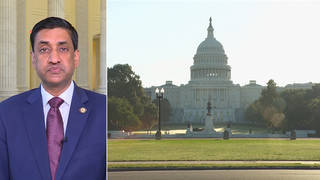
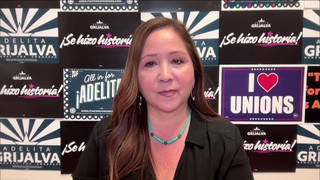
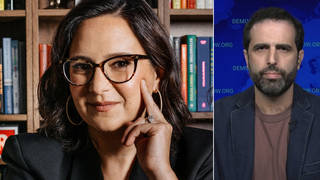
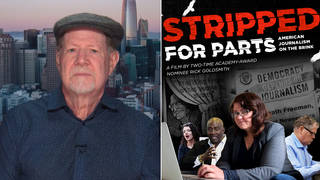


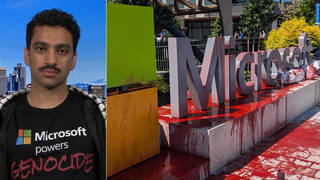
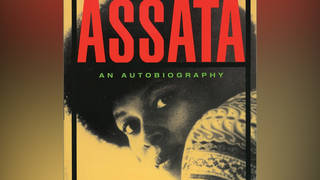

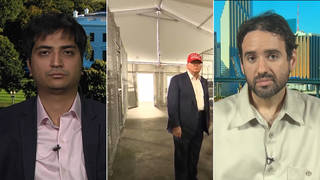
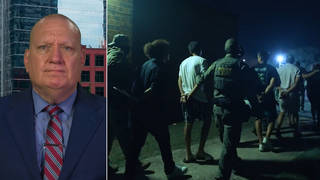
Media Options